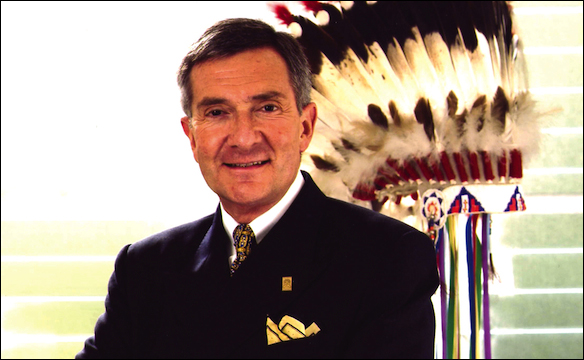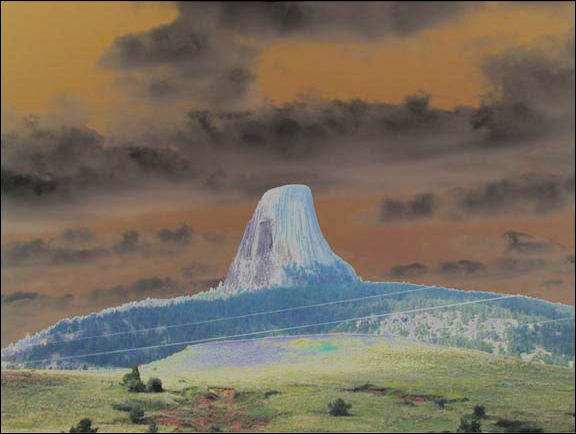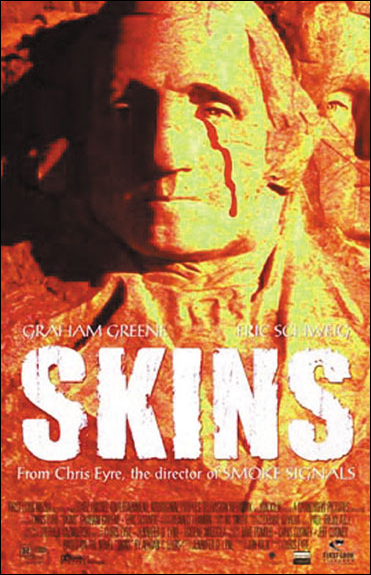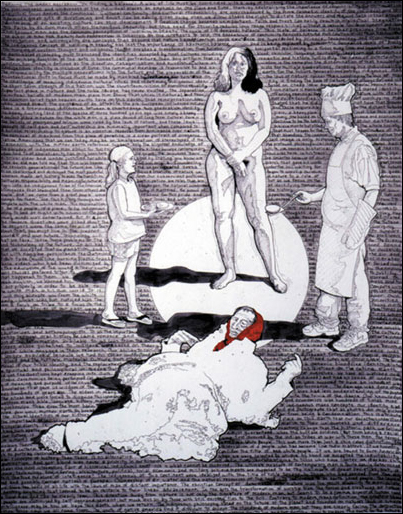Native Visions in History and Modernity: An Interview with W. Richard West
An Interview with W. Richard West, Founding Director of the Smithsonian National Museum of the American Indian
DKR – As the son of artist Dick West, what role did the arts play in your life when you were growing up?
WRW – The arts played a very central role. I grew up during what was probably the most significant period of my father’s art making. He was in a period of professional ascension and he took great pride and pleasure in his creation of art. He was primarily painting then although he became a three-dimensional artist later on in his life, when he moved into sculpture. It was a time when the Native art scene in Oklahoma was in a period of great flowering (from the late forties into the early sixties). My father was very much a part of what in Native art history is referred to as the Oklahoma Native School of Art. There were a number of very significant Plains artists at that time in Oklahoma who included my dad, Oscar Howe, who was from the Dakotas but was very well known in Oklahoma, and Black Bear Bosin, who was self-trained but had immense talent. That group of artists in some ways defined the Native arts of that period. It was an important and luscious time.

DKR – How did your experiences with Native American art shape your vision of what was to become the Smithsonian National Museum of the American Indian?
WRW – It’s interesting that you should ask that because in some respects it was contrapuntal. I have always had a deep appreciation of the sheer beauty of Native objects. That includes historic ethnographic material as well as contemporary arts, whether its pottery, painting, or sculpture. In the Native community there wasn’t this bright line between fine arts on the one hand and low arts or craft on the other. Art was created across a spectrum that included everything from basket weaving and pottery to painting and sculpture. Those things made by Native people and Native artists through time deserved to be considered something other than “ethnographic material.” They had been consigned to the anthropology category rather than the art category. I remember back in the late fifties and sixties that sometimes Native artists like my father, even though they were quite talented, had difficulty exhibiting their work. My dad showed a painting at the Corcoran Biennial that was juried and invitational back in the early sixties. But it was practically unheard of that Native artists were invited to exhibit their work in mainstream venues. So, I had all that sitting in my mind and at the same time I believe that if you’re trying to look at a Native object, whether it’s a historic Mimbres pot or a painting that was painted two weeks ago, there is a respect in which that object is never seen as an art object alone. There is not a separation of art from life in Native communities that you see in Western art. You didn’t always see it in Western art either. A linear approach to higher and higher art is the aftermath of the Renaissance. Before that, art was not really separated from life. Religious objects were a part of life, not art objects alone. So here at the NMAI we are trying to walk this very fine line that allows connoisseurs who want to approach Native objects on an aesthetic level to have the freedom and luxury to do so in our galleries. At the same time, we have consistently tried to invoke Native voice in all that we do and to put a Native imprimatur on the interpretation of ideas and objects in our collections, and to grace these beautiful things with that contextualization that gives meaning to the objects that their makers had in mind. At the same time, we mustn’t fall over the edge, and return to old ethnographic approaches to Indian art. We need to negotiate rather difficult new territory.

DKR – How do you view the museum’s role in fostering Native American contemporary art?
WRW – I believe that the museum’s role should be front and center in fostering Native American contemporary art. I can think of two categories of Native American art in question. One is those historic modes and traditions that are being made now, whether it’s a beaded moccasin, a Navajo weaving, or what have you. At the same time, I want Native artists to be able to experiment in a couple of different ways. The works of my father that I find most significant are those paintings in which he began to depart from the traditional framework that had always guided Plains painting among Native Americans. Dad began experimenting with abstraction and non-representational imagery. He was trying to negotiate that boundary between contemporary European work and Native artistic traditions. He was at difficulty on either side of the spectrum. On the Native side he was criticized for not “painting Indian” whatever that means, and on the other hand people had difficulty accepting his work because it was painted by an Indian. Experimentation is extremely important and the museum should protect Native artists and give them the freedom to explore that territory. The other aspect of experimentation involves completely new media like film, which I do consider an art form. Film is a medium that was certainly not ours traditionally and yet we have moved into film making, bringing it into our own lives, and that’s very healthy. I want to protect our ability to do that too. I do not want the creativity of Native artists to be guided solely by the commercial market, even though I know they cannot avoid it completely. There are commercial expectations of Native art that just chill my blood.

DKR – The Cultural Resource Center in Suitland, Maryland, houses the museum’s collection in a way that it can be easily accessed and shown to visitors. The Resource Center also hosts social service programs. Do you believe that viewing art and artifacts can have a healing effect which counteracts feelings of alienation among Native Americans in contemporary society?
WRW – Absolutely. I believe that this material and enhanced accessibility to it on the part of Native peoples, can have a powerful healing effect. There are a number of ways in which this can occur. We are under a federal mandate to implement a repatriation program here at the NMAI and at other museums. Some of this material, of a prescribed nature, that is to say human remains, funerary objects, sacred material, and cultural patrimony, are upon request and after due process to be returned to those communities that have a contemporary cultural affiliation with that material. I have been in this job long enough and our repatriation program has been in existence long enough for me to have witnessed the powerful healing effect that has had in many communities. But it goes beyond that. It’s not just the material that’s returned. Art making continues to be at the very center of how Native people define their lives and live happily or satisfactorily. There is so much in our collection that will never be repatriated but which motivates the creative impulses of Native artists. That is the reason we have the Artist Fellows Program at the NMAI and we have a unique requirement. We want contemporary Native artists to have access to objects for their own personal artistic and creative inspiration. On the other hand, we require that they use this experience as an NMAI Artist Fellow to not only inspire themselves personally as artists but also to bring something through them and their experience to the Native community from which they come. Objects can be very personal, they have tremendous artistic impact, and yet they are part of ongoing community life. Having watched my father and his work with Native communities, I consider artists to be among our cultural healers. They are the ones most capable of transmitting cultural information through time. They are the culture bearers for contemporary Native communities. As such they are the catalytic device that effects the kind of healing you refer to.

DKR – Are there particular Native American contemporary artists whose work interests you?
WRW – One’s appreciation of art is always a very personal matter so I am offering my personal judgment on this. I respect artists who are unafraid to experiment, and who are right there at the edge of the envelope challenging the lines between Native and non-Native art making. Among them are Jaune Quick-To-See Smith, Tony Abeyta, Harry Fonseca, Bob Haozous, and Jean LaMarr who is a splendid California artist. Tammy Garcia is a ceramist whose experimentation has gotten her into difficulty with some of the traditionalists in her community, but I admire her work.

DKR – What do you
see as the most important influences of Native American art and culture on
American society at large?
WRW – Hopefully we all appreciate beauty. Beauty does good things for humanity
as far as I’m concerned and our objects convey a sense of beauty to people who
see them. But much more particularly, Native art is a window on the soul of
Native America, and always has been. Historical and traditional material is
equally revealing. You cannot look at a painting or a collage made by Jaune
Quick-To-See Smith or a sculpture that has political knife edges to it, created
by Bob Haozous, without having a better appreciation of what is going on in
this segment of American cultural heritage. Native culture sits right at
America’s beginning point, is very much a part of its present, and will be a
part of its future.
Special thanks to Raquel Chapa, Scott Merritt, and Leslie Williamson.
© 2002 Daniel Rothbart. All rights reserved.